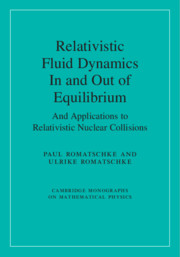 Relativistic Fluid Dynamics In and Out of Equilibrium
Relativistic Fluid Dynamics In and Out of Equilibrium Book contents
- Frontmatter
- Contents
- Preface
- 1 Outline, Notation, Preliminaries
- 2 Modern Theory of Fluid Dynamics
- 3 Microscopic Theory Background
- 4 Simulating Relativistic Nuclear Collisions
- 5 Comparison to Experimental Data
- 6 Conclusions
- Appendix A Relativistic Velocities
- Appendix B Riemann, Ricci, Christoffels, and All That
- Appendix C Coordinate Systems Used
- References
- Index
4 - Simulating Relativistic Nuclear Collisions
Published online by Cambridge University Press: 29 April 2019
- Frontmatter
- Contents
- Preface
- 1 Outline, Notation, Preliminaries
- 2 Modern Theory of Fluid Dynamics
- 3 Microscopic Theory Background
- 4 Simulating Relativistic Nuclear Collisions
- 5 Comparison to Experimental Data
- 6 Conclusions
- Appendix A Relativistic Velocities
- Appendix B Riemann, Ricci, Christoffels, and All That
- Appendix C Coordinate Systems Used
- References
- Index
Summary
This chapter reviews the basic ingredients of simulating relativistic nuclear collisions, of which fluid dynamics is one component. Nuclear geometry models with and without subnucleonic degrees of freedom are discussed, energy deposition at weak and strong coupling is reviewed and found to lead to similar results as the simple Glauber model with number of collision scaling. Initial state eccentricities are calculated, numerical algorithms to solve relativistic dissipative fluid dynamics are discussed and the freeze-out from fluid to particle degrees of freedom (hadronization) is described. The chapter closes with a discussion on how to calculate relevant observables in relativistic nuclear collision experiments.
Keywords
- Type
- Chapter
- Information
- Relativistic Fluid Dynamics In and Out of EquilibriumAnd Applications to Relativistic Nuclear Collisions, pp. 96 - 143Publisher: Cambridge University PressPrint publication year: 2019
